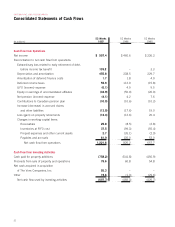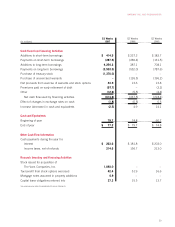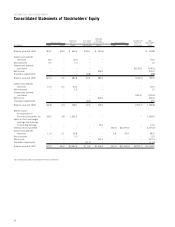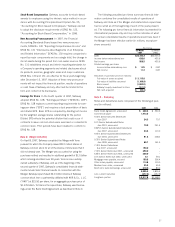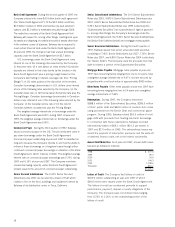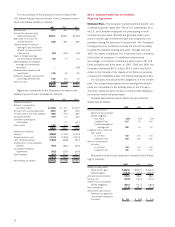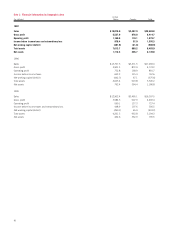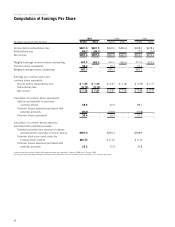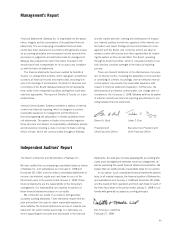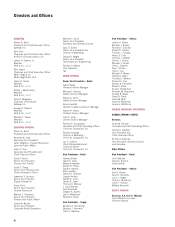Safeway 1997 Annual Report Download - page 34
Download and view the complete annual report
Please find page 34 of the 1997 Safeway annual report below. You can navigate through the pages in the report by either clicking on the pages listed below, or by using the keyword search tool below to find specific information within the annual report.
31
Additional Stock Plan Information As discussed in Note A, the
Company continues to account for its stock-based awards using
the intrinsic value method in accordance with Accounting
Principles Board Opinion No. 25, “Accounting for Stock Issued
to Employees,” and its related interpretations. Accordingly, no
compensation expense has been recognized in the financial
statements for employee stock arrangements.
Statement of Financial Accounting Standards No. 123,
“Accounting for Stock-Based Compensation,” requires the disclo-
sure of pro forma net income and earnings per share as if the
Company had adopted the fair value method as of the beginning
of fiscal 1995. Under SFAS 123, the fair value of stock-based
awards to employees is calculated through the use of option pric-
ing models, even though such models were developed to estimate
the fair value of freely tradable, fully transferable options without
vesting restrictions, which significantly differ from the Company’s
stock option awards. These models also require subjective
assumptions, including future stock price volatility and expected
time to exercise, which greatly affect the calculated values. The
Company’s calculations were made using the Black-Scholes
option pricing model with the following weighted average assump-
tions: seven to nine years expected life to vesting; stock volatility of
31% in 1997, 30% in 1996 and 29% in 1995; risk-free interest
rates of 6.29% in both 1997 and 1996 and 6.50% in 1995; and
no dividends during the expected term.
The Company’s calculations are based on a single option val-
uation approach and forfeitures are recognized as they occur.
However, the impact of outstanding non-vested stock options
granted prior to 1995 has been excluded from the pro forma cal-
culation; accordingly, the pro forma results presented below are
not indicative of future period pro forma results. Had compensa-
tion cost for the Safeway’s stock option plans been determined
based on the fair value at the grant date for awards in 1995,
1996 and 1997, consistent with the provisions of SFAS No. 123,
the Company’s net income and earnings per share would have
been reduced to the pro forma amounts indicated below:
1997 1996 1995
Net income (in millions):
As reported $557.4 $460.6 $326.3
Pro forma 553.5 459.0 325.8
Basic earnings per share:
As reported $ 1.21 $ 1.06 $ 0.77
Pro forma 1.20 1.05 0.77
Diluted earnings per share:
As reported $ 1.12 $ 0.97 $ 0.68
Pro forma 1.11 0.96 0.68
Repurchases of Common Stock and Warrants to Purchase
Common Stock In connection with the Merger described in Note
B, the Company repurchased 64.0 million shares of Safeway
common stock from a partnership affiliated with KKR at $21.50
per share, for an aggregate purchase price of $1.376 billion. The
repurchased shares are reported as treasury shares in the accom-
panying balance sheet. When treasury shares are reissued, any
excess of the acquisition cost of the shares over the proceeds
received is charged to paid-in capital. At year-end 1997, KKR
owned 110.2 million shares of Safeway common stock.
At year-end 1997, warrants (the “SSI Warrants”) to purchase
30.7 million shares of the Company’s common stock at $0.50
per share were held by SSI Equity Associates, L.P. (“SSI”), a lim-
ited partnership whose sole assets consist of the SSI Warrants.
The SSI Warrants are exercisable through November 15, 2001.
SSI Partners, L.P., an affiliate of KKR, is the general partner of
SSI. During 1996 and 1995, the Company acquired 64.5% of
the partnership interests in SSI for $322.7 million with proceeds
from bank borrowings, which was accounted for as a reduction
to stockholders’ equity.
Outstanding common stock and the effect of options and war-
rants at year-end 1997 are summarized as follows (in millions):
Potential
Proceeds
from
Shares Exercise
Common stock outstanding (net of
61.2 shares of treasury stock) 476.2
Options to purchase common stock 41.0 $ 308.7
SSI Warrants 10.9 5.4
■■
Total 528.1 $ 314.1
■■
Note G: Taxes on Income
The components of income tax expense are as follows (in millions):
1997 1996 1995
Current:
Federal $303.6 $162.9 $157.9
State 57.5 30.7 29.9
Foreign 37.8 (0.5) 56.2
■■■■■■■■
398.9 193.1 244.0
■■■■■■■■
Deferred:
Federal 40.4 49.3 8.2
State 8.4 12.6 (0.8)
Foreign 7.1 52.0 (23.2)
■■■■■■■■
55.9 113.9 (15.8)
■■■■■■■■
$454.8 $307.0 $228.2
■■■■■■■■
Extraordinary losses are presented net of related tax benefits.
Therefore, 1997 and 1995 income tax expense in the above
table excludes tax benefits of $41.1 million and $1.3 million on
extraordinary losses related to the early retirement of debt. Tax
benefits from the exercise of employee stock options of $42.4
million in 1997, $51.9 million in 1996 and $16.6 million in
1995 were credited directly to paid-in capital and, therefore, are
excluded from income tax expense.



